44 drag each label into the appropriate position in order to identify which type of macromolecule is the target of each digestive enzyme or compound
9.1 The Structure of DNA - Concepts of Biology - 1st Canadian Edition The DNA molecule is a polymer of nucleotides. Each nucleotide is composed of a nitrogenous base, a five-carbon sugar (deoxyribose), and a phosphate group. There are four nitrogenous bases in DNA, two purines (adenine and guanine) and two pyrimidines (cytosine and thymine). A DNA molecule is composed of two strands. Transport of Oxygen in the Blood | Biology for Majors II Describe how oxygen is bound to hemoglobin and transported to body tissues. Although oxygen dissolves in blood, only a small amount of oxygen is transported this way. Only 1.5 percent of oxygen in the blood is dissolved directly into the blood itself. Most oxygen—98.5 percent—is bound to a protein called hemoglobin and carried to the tissues.
Enzymes and the active site (article) | Khan Academy The answer depends on the enzyme. Some enzymes speed up chemical reactions by bringing two substrates together in the right orientation. Others create an environment inside the active site that's favorable to the reaction (for instance, one that's slightly acidic or non-polar).
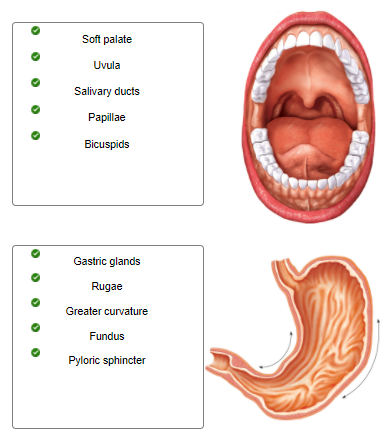
Drag each label into the appropriate position in order to identify which type of macromolecule is the target of each digestive enzyme or compound
11.2 Digestive System - Concepts of Biology - 1st Canadian Edition The stomach is a saclike organ that secretes gastric digestive juices. Protein digestion is carried out by an enzyme called pepsin in the stomach chamber. The highly acidic environment kills many microorganisms in the food and, combined with the action of the enzyme pepsin, results in the catabolism of protein in the food. Digestive Flashcards | Quizlet digestion is the breakdown large organic molecules into component parts that can be absorbed. carbohydrates are digested into (monosaccharides), protein into (amino acids), and triglycerides into fatty acids and glycerol match the types of digestion with the correct description mechanical digestion- includes mastication and mixing food Solved > Drag each label into the appropriate position in ... - ScholarOn Drag each label into the appropriate position in order to identify which type of macromolecule is the target of each digestive enzyme or compound.... Drag each label into the appropriate position to identify what type of immunity is classified by each label.....this is the only one I have left...
Drag each label into the appropriate position in order to identify which type of macromolecule is the target of each digestive enzyme or compound. AP Biology - CourseNotes 3 reactions changing glucose into a compound that can be readily cleaved into 3-carbon phosphorylated molecules; 2 of the reactions require use of ATP; step B - cleavage/rearrangement 2 reactions break up 6-carbon molecule into 2 3-carbon molecules; 1st of 2 reactions forms G3P and another molecule that turns into G3P through the 2nd reaction Solved Drag each label into the appropriate position in - Chegg question: drag each label into the appropriate position in order to identify which type of macromolecule is the target of each digestive enzyme or compound gastric lipase pancreatic amylase lactase lecithin carboxypeptidase salivary amylase dipeptidase maltase pancreatic lipaso lingual lipase aminopeptidase sucrase dextrinase bile salts trypsin … BIOLOGY E - Essay Help 1) When would a cell use the dehydration and hydrolysis reaction of polysaccharides? (ii) Identify each type of reaction: K4 a. 2NaOH + H2SO4 -> Na2So4 + 2H20 b. C6H12O6 + 602 -> 6CO2 + 6H20 c. … Under normal conditions, you would not expect to see this in urine or glomerular filtrate? Albumin. Glucose. Amino ACIDS. Phosphate ions. Molecular Structure and Function - Opportunities in Biology - NCBI ... The properties of proteins must be determined by the amino acids they contain and the order in which they are linked. While these properties may become complex and far removed from any property inherent in single amino acids, the existence of a limited set of fundamental building blocks restricts the ultimate functional properties of proteins.
Digestive Enzymes and its Types -Amylase, Protease and Lipase Amylase is defined as a digestive enzyme that breaks starch into small carbohydrate molecules. This enzyme is produced in two areas. Firstly, salivary glands in our mouth generate salivary amylase that starts the process of digestion by breaking down starch and converting into maltose and smaller carbohydrate. BILOGY C - Essay Help 1) Choosing a Micropipettor For each of the following volumes, which micropipettor would be most appropriate to use (P1000, P200, or P20)? EX. 737 ul P1000 1. 1 pl 2. 19 pl 21 ul 4. 150 pl 400 pl C Draw a labelled diagram that explains the pressure-flow model of nutrient movement inside phloem in plants. Cara Nak Buat Akaun Sspn-i Bank Islam Blog Drag each label into the appropriate position in order to identify which type of macromolecule is the target of each digestive enzyme or compound. Which are organs or accessory organs of the digestive system. The organs discussed above are the organs of the digestive tract through which food passes. redirect.prod.mastering.pearsoncmg.com Labeling, ranking, sorting, or sentence completion questions. All of these question types require you to position items into an area of the answer box. Answer these kinds of questions on a computer, not on a smartphone. Press Tab to move forward or Shift/Tab to move backwards through the provided answer items.
Solved drag each label into the appropriate position in | Chegg.com Al rights reser 9 each tabel Into the appropriate position in order to identify which type of macromolecule is the target of each digestive enzyme or compound Lipid Protein Carbohydrate Trypin Pancreatic Swamy Unge Pancreatice HC Chymotrypsin Boat Gait Drag and drop then you can the comediwhen the box when it shoulder CH103 - Chapter 8: The Major Macromolecules - Chemistry 11.1 Introduction: The Four Major Macromolecules Within all lifeforms on Earth, from the tiniest bacterium to the giant sperm whale, there are four major classes of organic macromolecules that are always found and are essential to life. These are the carbohydrates, lipids (or fats), proteins, and nucleic acids. Drag each label into the appropriate position in order to identify ... Drag each label into the appropriate position in order to identify where each secretion enters the GI tract. Complete each sentence by dragging the proper label into the appropriate position.Then, re-arrange the sentences into a logical order of digestive processes. Complete each sentence by dragging the proper label into the correct position. Monosaccharides - an overview | ScienceDirect Topics The uptake of each monosaccharide via SGLT1 is coupled with the simultaneous transport of 2 Na +. As glucose and galactose are neutral molecules, their cotransport with 2 Na + renders the transport process electrogenic, i.e., leading to depolarization of the membrane with a net transfer of 2 positive charges into the cell per transport cycle.
BIO23 F19-S20 Complete Course Guide by Human Anatomy - Issuu List each type of bond in order by relative strength. b. Explain the mechanism of each type of bond. c. Provide biologically significant examples of each. ... Draw and label each of the functional ...
DOC Science Enhanced S&S Biology - Virginia Type of Macromolecule Elements (C, H, O, N, S, P) Monomer ... Have them label the parts of the cell as appropriate, showing at least the. cell wall. cytoplasm. nucleus. nuclear membrane. chromosomes. chromatin. cell plate. 2. For fresh material, have students use the procedure found in a standard reference manual, or use the method described at ...
Chapter 17 digestive Flashcards - Easy Notecards Drag each label into the appropriate position in order to identify which type of macromolecule is the target of each digestive enzyme or compound. 20 Indicate where each enzyme (or its inactive precursor) is produced. 21 Classify each enzyme based on the substrate it decomposes. 22 The figures depict the stages of swallowing.
HW 19 (25.6 & 26.1).docx - 1. Drag each label into the appropriate ... Drag each label into the appropriate position in order to identify which type of macromolecule is the target of each digestive enzyme or compound. a. CARBOHYDRATE: pancreatic amylase, dextrinase, glucoamylase, lactase, salivary amylase, maltase, sucrase b.
Cellular organelles and their functions - Kenhub The cytoplasm is a fluid matrix that usually surrounds the nucleus and is bound by the outer membrane of the cell. Organelles are small structures within the cytoplasm that carry out functions necessary to maintain homeostasis in the cell. They are involved in many processes, for example energy production, building proteins and secretions ...
A&P Ch 17 Digestive Homework Flashcards - Quizlet The root canal of a tooth contains gingiva. blood vessels and nerves. cementum. dentin. blood vessels and nerves. Anatomy of stomach and oral cavity Identify whether the structures are associated with the oral cavity or the stomach by dragging each label into the appropriate position. Oral: Bicuspids Uvula Salivary ducts Papillae Soft palate
Solved > Drag each label into the appropriate category to:277813 ... Drag each label into the appropriate position in order to identify which type of macromolecule is the target of each digestive enzyme or compound.... Drag each label into the appropriate position to identify what type of immunity is classified by each label.....this is the only one I have left...
Solved > Drag each label into the appropriate position in ... - ScholarOn Drag each label into the appropriate position in order to identify which type of macromolecule is the target of each digestive enzyme or compound.... Drag each label into the appropriate position to identify what type of immunity is classified by each label.....this is the only one I have left...
Digestive Flashcards | Quizlet digestion is the breakdown large organic molecules into component parts that can be absorbed. carbohydrates are digested into (monosaccharides), protein into (amino acids), and triglycerides into fatty acids and glycerol match the types of digestion with the correct description mechanical digestion- includes mastication and mixing food
11.2 Digestive System - Concepts of Biology - 1st Canadian Edition The stomach is a saclike organ that secretes gastric digestive juices. Protein digestion is carried out by an enzyme called pepsin in the stomach chamber. The highly acidic environment kills many microorganisms in the food and, combined with the action of the enzyme pepsin, results in the catabolism of protein in the food.
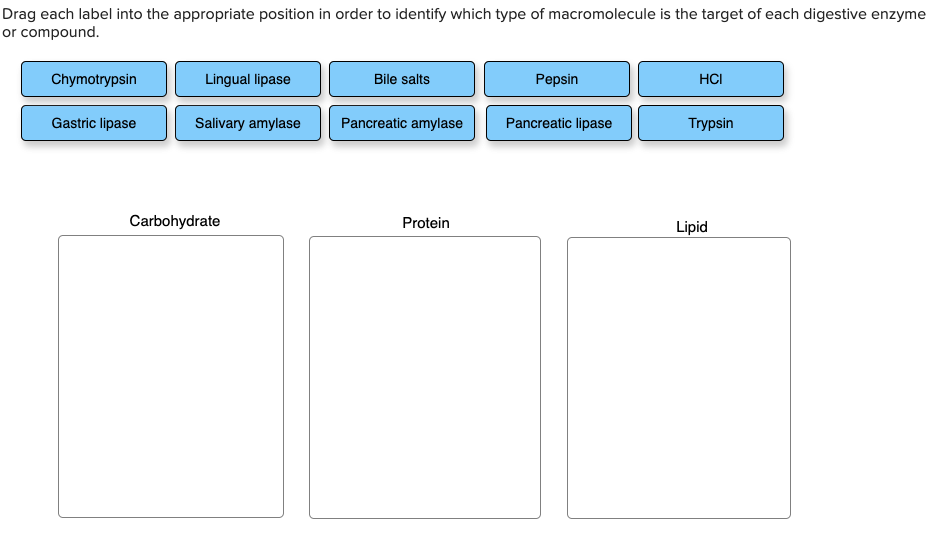




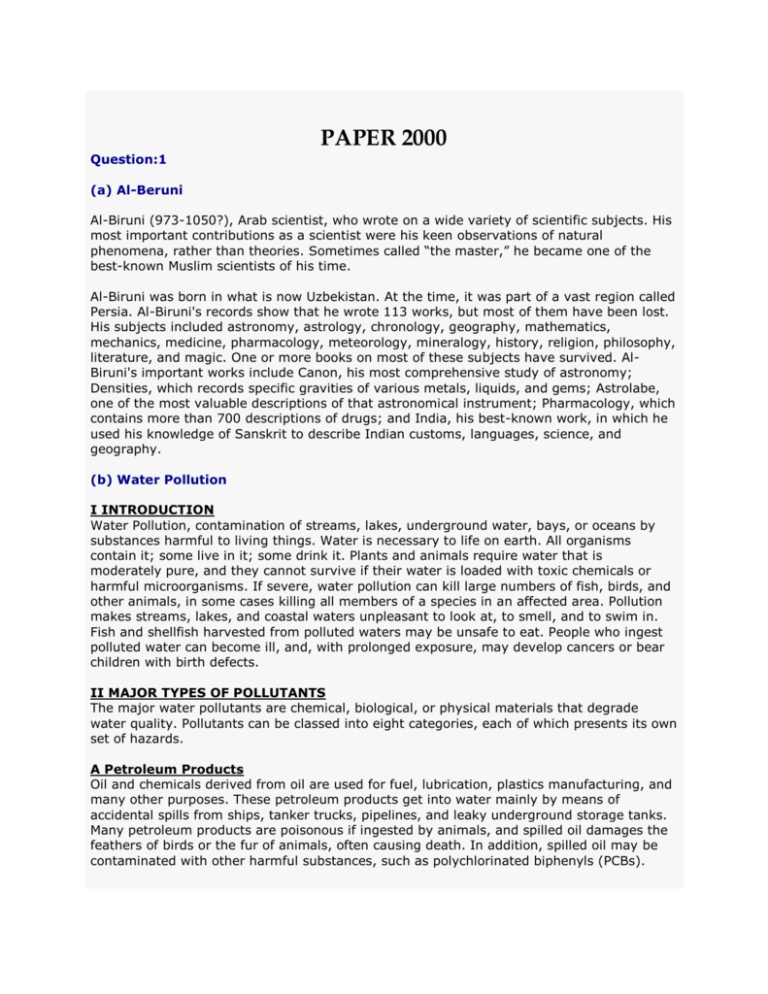
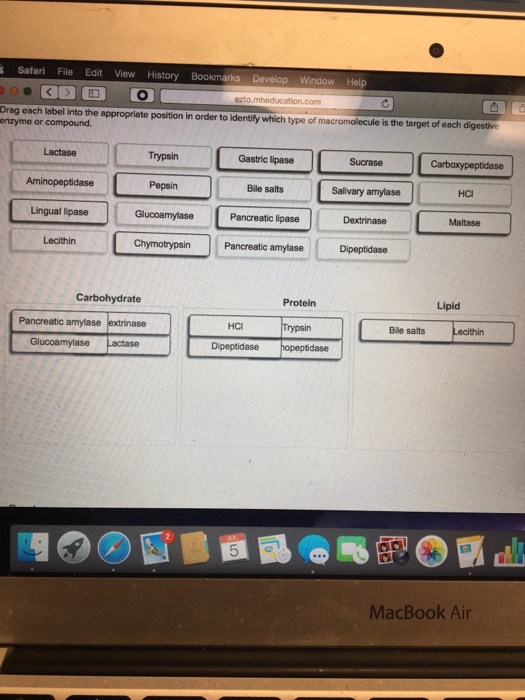


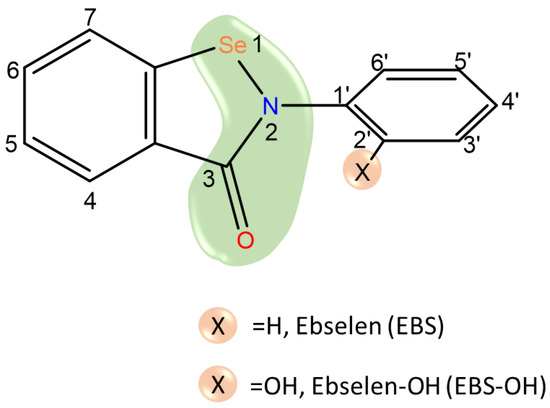



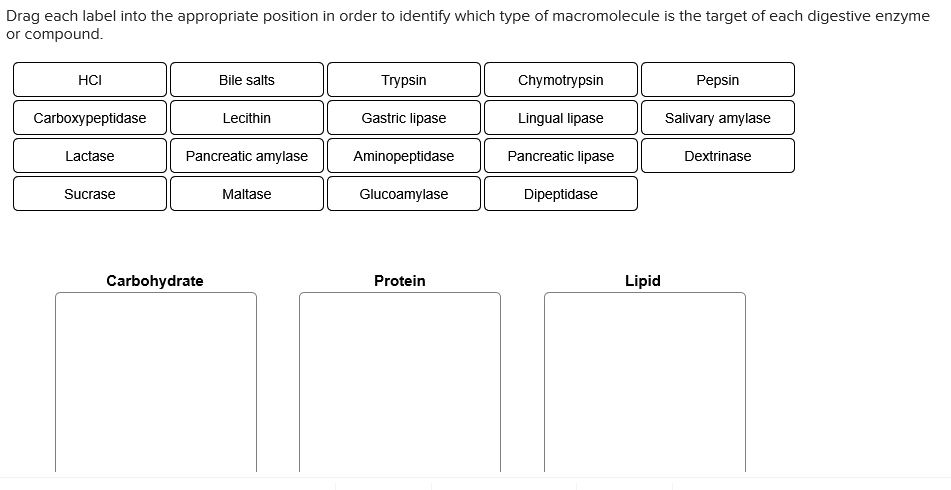







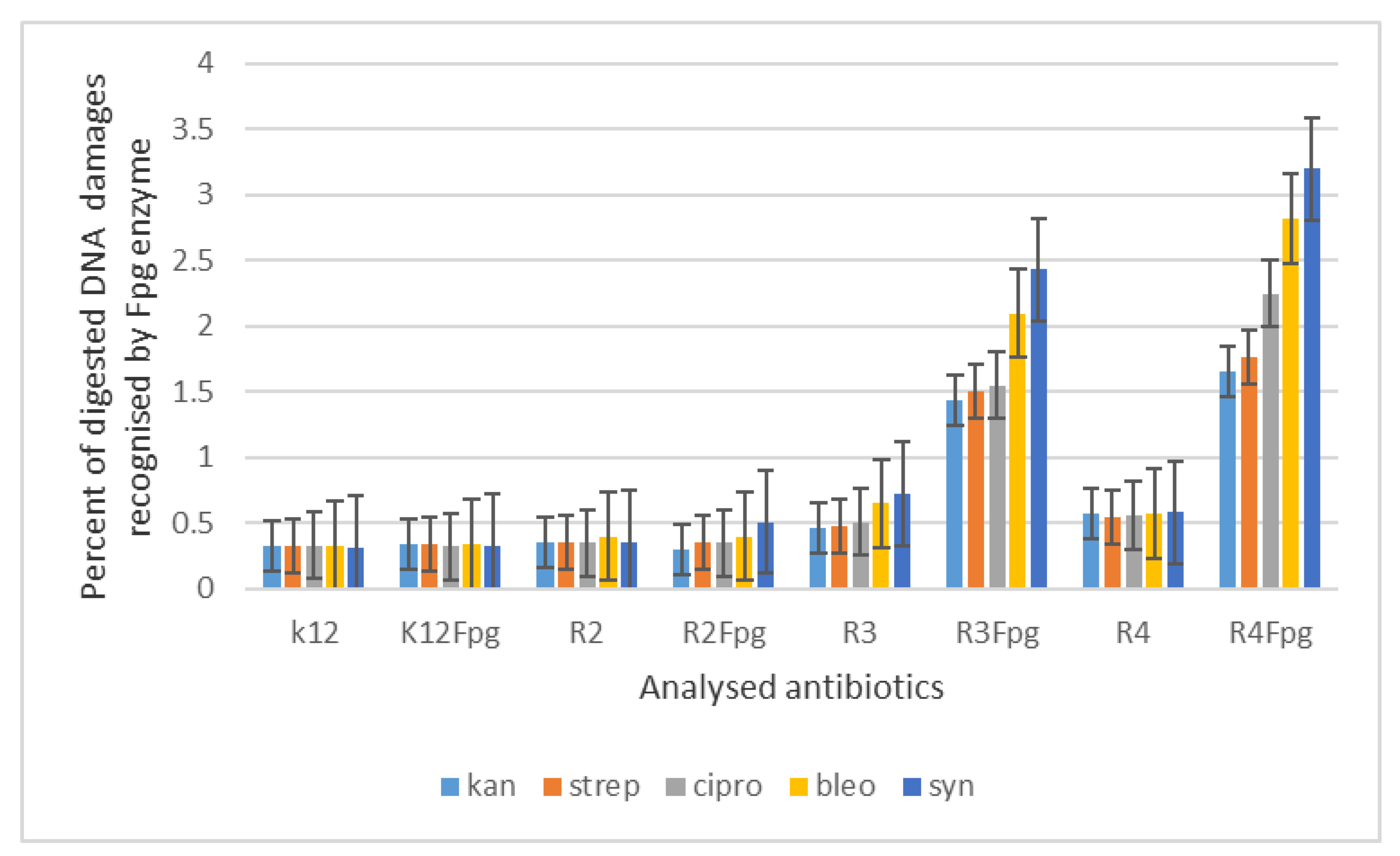


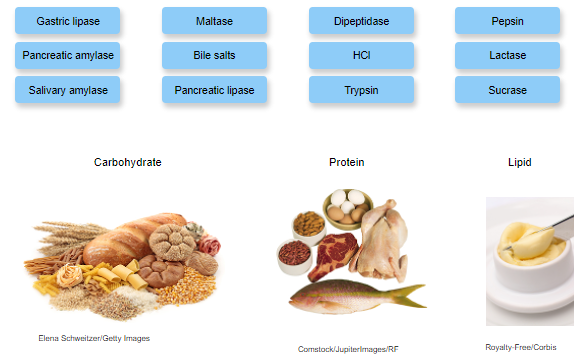

Post a Comment for "44 drag each label into the appropriate position in order to identify which type of macromolecule is the target of each digestive enzyme or compound"